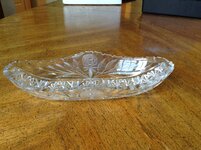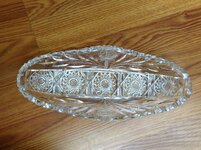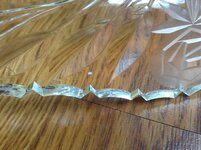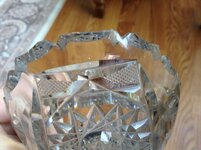EmptyPockets
Jr. Member
- Mar 16, 2013
- 80
- 61
- Detector(s) used
- Garrett AT Gold & Pro Pointer & Whites Prism II
- Primary Interest:
- All Treasure Hunting
I'm really not sure of the best place to post this mini-tutorial, hence posting in the General Discussion Forum. Please move as appropriate.
How to identify genuine American Brilliant Cut Glass
This little how to identify ABC is not all inclusive, rather I want to show you some of the characteristics of ABC. Check out the link from Brilliant Glass to read more. I thought it would be helpful to see images of real and reproduction.
1. Look for a company marking such as Hawkes or other company such as Libbey, Bergen, Alford and etc....
2. The glass will be very clear when looking through an uncut section. There will be no distortions of images when looking through the clear section.
3. Glass cutters of that time will use an abrasive wheel. Look for Non-parallel abrasions. The cutter will then buff the glass to smooth out the cuts.
4. A signature his highly counterfeited. If there is a cutters signature, then look at the piece very closely. Counterfeit signatures are electro-penciled. Real signatures are acid etched. Rub your fingernail across the signature: real etched and smooth, forged will catch your fingernail.
5. Us a long wave length light in a dark room. Real ABC will have a yellow-green hue. Reproductions have a pink hue.
You can find detailed identifying characteristics at this website:
How to Tell American Brilliant P
Examples from my own collection of real and counterfeit American Brilliant Cut glass:
First, the real deal with a possible forged signature. I say possible because I’m not sure.
T.G. Hawkes Mustard Jar.
Bought for $19.

The Hawkes Company Marking.

Close-up of the Hawkes etching.

Cutting wheel abrasions not parallel. I used software to overmark some of the cuts with a white line. You should see them easily.
[

How to identify genuine American Brilliant Cut Glass
This little how to identify ABC is not all inclusive, rather I want to show you some of the characteristics of ABC. Check out the link from Brilliant Glass to read more. I thought it would be helpful to see images of real and reproduction.
1. Look for a company marking such as Hawkes or other company such as Libbey, Bergen, Alford and etc....
2. The glass will be very clear when looking through an uncut section. There will be no distortions of images when looking through the clear section.
3. Glass cutters of that time will use an abrasive wheel. Look for Non-parallel abrasions. The cutter will then buff the glass to smooth out the cuts.
4. A signature his highly counterfeited. If there is a cutters signature, then look at the piece very closely. Counterfeit signatures are electro-penciled. Real signatures are acid etched. Rub your fingernail across the signature: real etched and smooth, forged will catch your fingernail.
5. Us a long wave length light in a dark room. Real ABC will have a yellow-green hue. Reproductions have a pink hue.
You can find detailed identifying characteristics at this website:
How to Tell American Brilliant P
Examples from my own collection of real and counterfeit American Brilliant Cut glass:
First, the real deal with a possible forged signature. I say possible because I’m not sure.
T.G. Hawkes Mustard Jar.
Bought for $19.

The Hawkes Company Marking.

Close-up of the Hawkes etching.

Cutting wheel abrasions not parallel. I used software to overmark some of the cuts with a white line. You should see them easily.
[

Last edited:



















